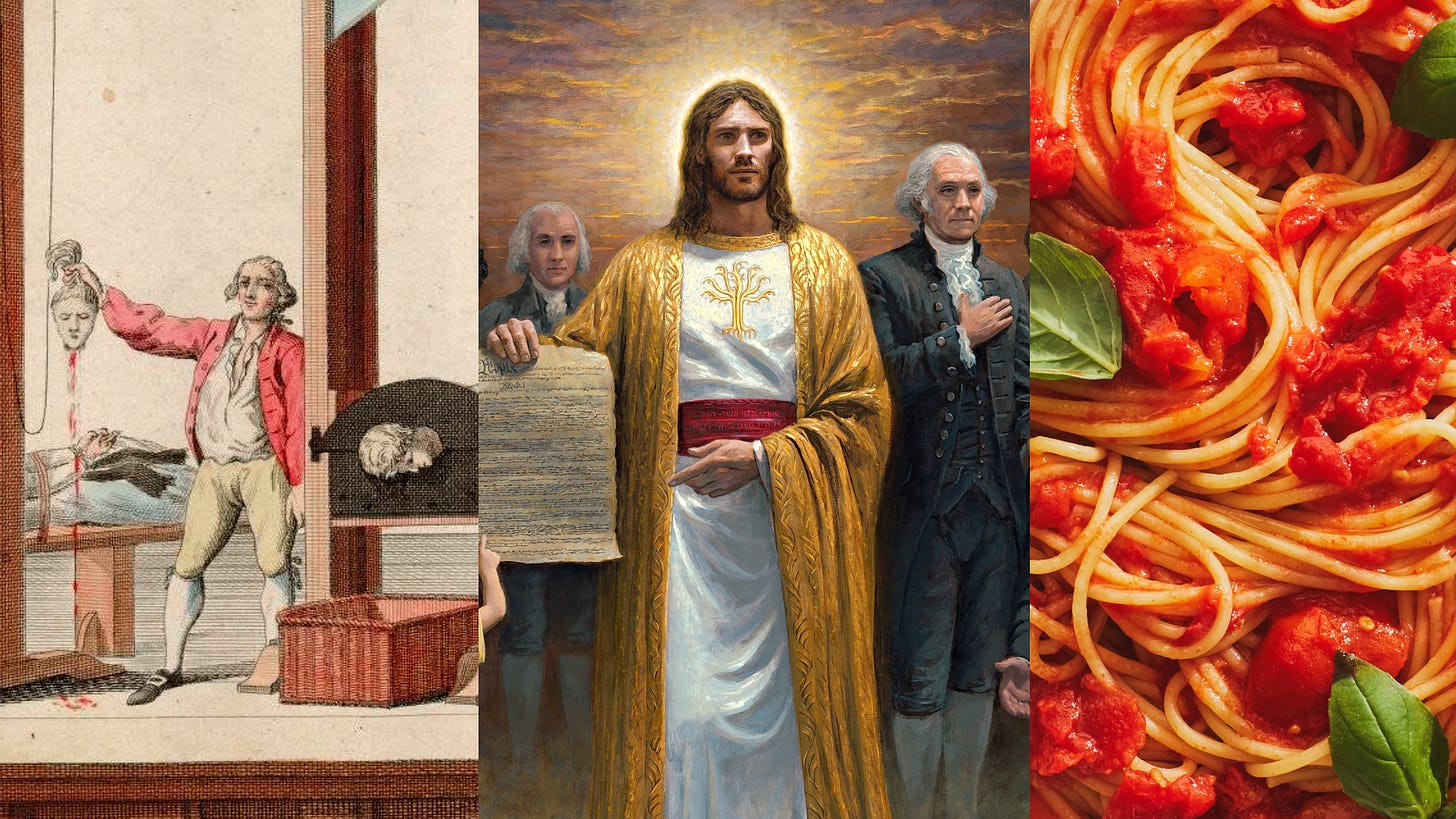Myth: Nero fiddled while Rome Burned
Nero Claudius, the fifth Roman emperor and the last of the Julio-Claudian line, gets a bad rap. Along with Caligula, he’s viewed as the archetypal tyrannical ruler of antiquity — cruel and ruthless, a real throw-the-Christians-to-the-lions kind of guy. It is said that Nero, in his madness, set fire to Rome and watched it burn, fiddling as the capital of the world’s greatest empire burned to the ground. What a diabolical character, right?
Or so the popular perception goes. But unlike Caligula, who was certifiably insane, Nero’s main flaw wasn’t madness or excessive tyranny — he was just a naïve kid with insufficient political wits to govern an entity as powerful and complex as the Roman empire, preferring artistry to politics. In reality, Nero wasn’t even in Rome when the fire broke out. There is no real evidence of any kind of fiddling, either (it hadn’t even been invented yet). In fact, after Nero received the news, he returned to Rome to personally oversee relief efforts.
Now, let’s not get too rosy a picture of Nero — he was a tyrant, like any Roman emperor, and he blamed the Christians for the fire to avoid responsibility. He presided over the brutal suppression of Boudica’s rebellion in Britannia. He was not a good man. But the claim that he was Joffrey Lannister just doesn’t hold up.
We don’t know for sure where this legend came from, but given the later dominance of Christianity in the Roman empire, and Nero’s persecution of Christians, it’s likely that later Christian scholars were not disposed to kindness in their assessments of him. Nero lacked the political savvy that makes for effective rulers, but a deranged madman, he was not.
Myth: J. Edgar Hoover was a cross-dresser
Utter the name J. Edgar Hoover in a room full of people who can name the three branches of government, and everyone will tell you, with a knowing smile, that he was a cross-dresser. Hoover (no relation to Herbert) was an institution unto himself in 20th century America. From 1924 to 1972, Hoover served as the director, first of the Bureau of Investigations, and then of the Federal Bureau of Investigations, which he helped to found. The only thing J. Edgar hated more than communism was civil liberties and letting go of power, and during his 48-year career — which spanned eight presidents — he rubbed quite a few people the wrong way.
As a lifelong bachelor with a gentleman companion with whom he often vacationed and was buried next to, it was hardly a leap to suppose that Hoover’s virulently anti-gay modus operandi was evidence that he doth protest too much.1 Gay rumors — which grew almost to the point of open secrets — followed him throughout his life, and although we do not have 100 percent definitive proof, there’s a good chance that Hoover was, in fact, gay or bisexual.
In the past 30 years, however, the assertion that Hoover was a cross-dresser has become widely believed. Aside from the fact that cross-dressing and sexual orientation are not necessarily connected — most gay and bisexual men do not cross-dress, and many cross-dressers are straight — this claim is supported by zero evidence. The sole source for this allegation is from a sensationalistic 1993 biography, wherein a bootlegger’s ex-wife claimed, in an interview for which she was paid, that Hoover donned fluffy dresses while having orgies with boys and making them read Bible passages.2 This is tabloid garbage, not historical fact.
Myth: The US Founding Fathers were Christians who founded a Christian nation
While many of the founding fathers were nominally Christians — that is to say, they belonged to one church or another on paper — they remained for the most part secular deists in their private lives, with the lone exception of Calvinist John Jay. James Madison,3 Alexander Hamilton, Benjamin Franklin, Thomas Jefferson, George Washington, John Adams, James Monroe, and Thomas Paine were deists. Paine even wrote a whole book about the internal contradictions in the Bible, and Jefferson took a pair of scissors to the Bible and compiled his own version that redacted all the claims to Christ’s divinity. Franklin? Jeez. There was no god that Franklin worshiped more than French titties. Hey, far be it from me to knock another guy’s religion, but that religion ain’t Christianity.
There is a reason why the Declaration of Independence references a deity, but not a specifically Christian one, and why the Constitution omits any reference to a god at all. “We the people” was a bit of a big deal, because it was opposed to “Me, the king ordained by God and if you disagree with me then you also disagree with Him.” If that isn’t explicit enough, the 1796 Treaty of Tripoli, signed by President John Adams, states that “The government of the United States of America is not in any sense founded on the Christian Religion.” America is a Christian majority nation. That’s not the same thing as being a Christian nation.
Myth: The French Revolution was an uprising of the people against the monarchy and aristocracy
If you know one thing about the French Revolution, it’s probably that the French people got really mad about all the poverty and inequality, and rose up in a people’s revolution where they gleefully executed their king and every aristocrat they could get their hands on. Chop goes the guillotine, and away goes the old aristocratic order.
Like most crocks of bullshit, it’s got a kernel of truth to it, but when you consider the facts, this notion just doesn’t pass muster. For example, without the liberal nobility, there wouldn’t be a French Revolution in the first place. Many nobles at the time were Enlightenment thinkers — reformists who wanted to change the monarchy into something more progressive, and leaders like Lafayette or the Duke of Orleans were instrumental in driving the revolution forward. When the king used his power to censor criticism, the Duke of Orleans used his own legal privileges to keep the presses running, because he believed in discourse and progress.4
Secondly, it’s not like the original revolutionaries themselves were very poor — then as now, utopianism was a privilege of the affluent. The revolutionaries were solidly middle or upper-middle class people; lawyers, doctors, and teachers, those with both an education and the money to get into politics.
And thirdly, the best-known period of the revolution — Robespierre’s time, under the Jacobins — is the one from which we get the most vivid imagery of the mass executions. To be sure, the Reign of Terror saw a lot of nobles slaughtered, but the vast majority of the victims were common people who hadn’t so much as a drop of blue blood in them. Tens of thousands of peasants were butchered in the Vendée uprising, many having been falsely snitched on by the increasingly paranoid Jacobin government.5 The proto-Stalinist dictatorship of the Committee of Public Safety did not discriminate with regard to social class, gender, or even age; many times, children were sent to be executed. The liberal nobles who had once been so instrumental in achieving the revolution were now on the chopping block — as were any revolutionaries who were not sufficiently patriotic.
The 1790’s was not a safe time to be a noble in France, but it wasn’t really a safe time to be anyone. The French Revolution was a messy, chaotic affair, driven by far more than a mere hatred of the aristocracy, and don’t let any reductive college socialist tell you otherwise.
Myth: Marco Polo brought pasta to Italy from China
Most culinary aficionados know that tomatoes originated in the New World, specifically Central and South America, and that they were not a part of the Italian diet prior. It is also popularly believed that the Italians didn’t invent pasta, either, but rather that Marco Polo introduced it to Italy after encountering noodles during his travels in China. What a bunch of food frauds those Italians are! Not so fast.
While Marco Polo did indeed encounter noodles in the Far East, and wrote about them in his memoirs, he did so with the kind of casual familiarity of one who expects his readers to know what he’s talking about. That’s because in the 13th century, when Polo made his journey, pasta had already been in regular use for many centuries in Italy. The Roman poet Horace wrote about a dish known as lasaga, a precursor to lasagna, way back in the 1st century CE.6 By the 5th century, cookbooks contained lasaga recipes that any modern reader would recognize.7
The myth that Marco Polo brought pasta to Italy from China originated from a 1929 article in the Macaroni Journal, a trade magazine for North American pasta makers, as a PR effort to get people to eat more pasta. Italian-Americans were one of the primary immigrant groups at the time, and attitudes toward them and their culture were often bigoted. Spinning pasta as actually being of Chinese origin may have seemed a way to gin up more sales. It’s hard to believe there was ever a time when pasta needed PR help, but there you have it.
Myth: Paul Revere’s Ride was what warned the Americans that the “British are coming!”
We all know the story of Paul Revere’s ride, largely thanks to the 1860 poem penned by Henry Wadsworth Longfellow. We all know that he was said to have shouted to the sleeping colonists, “The British are coming!” waking and thus preparing them for the coming war. The way it’s frequently referenced — as early as elementary school — would lead the less-discerning American to believe Paul Revere single-handedly warned the colonists of the impending conflict, riding through “Every Middlesex village and farm.” Merely looking at the absurdity that one person could travel the entire north and eastern parts of Massachusetts on horseback within the span of a few crucial hours, we start to see issues with the Longfellowian version of events. In fact, Paul Revere was only one of three main riders. The other two were named Joseph Warren (who actually hatched the plan to sound the alarm to begin with) and Samuel Prescott. Together, they were part of a network that made up a relay system pioneered during the French and Indian War designed to warn of incoming troops.
Oh, and that famous line, “The British are coming”? No one, Revere included, said those words, seeing as the colonists still saw themselves as essentially British. Revere and the other riders were far less loaded in their word choice, simply proclaiming “The Regulars are coming out!”
Myth: Slavery in the US was the very worst of its kind
American egocentricity dictates that when the US does something right, it’s the best thing ever. Similarly, when America does something evil, it must always be the worst and most surpassingly heinous instance the world has ever seen. As such, Americans tend to view slavery in the US not only as the abomination and national disgrace that it was, but as the single most brutal form of slavery man has ever inflicted upon man.
It goes without saying that slavery of all kinds is profoundly evil, but not all evil is created equal. If you’re familiar with Frederick Douglass, then you remember him being sent to the “breaker”, a local sociopath who would whip submission into troublesome slaves. If not, recall that scene in “Django Unchained” where Samuel L. Jackson tells the protagonist they’ll send him to a place that will simply work him to death, as a punishment worse than dying.
For much of the Caribbean and South America, this wasn’t a special punishment; it was the norm. A sugar plantation was a death sentence. A silver mine was a death sentence. On a large scale, it was often a debatable business position whether to provide food. You work. You die. Rinse and repeat. This is reflected in the fact that the US imported only about four percent of slaves, but accounted for half the slaves in the New World at the start of the Civil War. What do you think happened to the other 96 percent of the “new blood?”
The moral of this story isn’t to have a pissing contest of villainy, nor to downplay anyone’s suffering, but to provide some perspective on evil. If history has any true rule, it’s that if you think you’ve found the true depth of industrial human depravity, you haven’t gone deep enough.
See also: “Everything You Know About History Is Wrong” Part I, Part III, Part IV, and Part V
…
Jamie Paul is the Founder of American Dreaming and Managing Editor of Queer Majority.
Johan Pregmo is a Sweden-based writer and contributor to American Dreaming.
Timothy Wood is a US-based writer and editor, and contributor to American Dreaming.
Alexander von Sternberg is a US-based writer and editor, and the host of the History Impossible podcast.
Subscribe now and never miss a new post. You can also support the work on Patreon. Please consider sharing this on your social networks. You can reach me at @AmericnDreaming on Twitter, or at AmericanDreaming08@Gmail.com.
Secret City: The Hidden History of Gay Washington, from FDR through Clinton by James Kirchick, Henry Holt and Co., 2022, pages 47-48
Ibid. Page 47
Politics and Religion in the United States by Michael Corbett, Routledge, 2013, page 78
Radical and Chic, a Duke Who Courted Revolt and Doom by R. Wernick, Smithsonian, vol. 20, no. 4, July 1989, page 66
Crisis in Representation: Thomas Paine, Mary Wollstonecraft, Helen Maria Williams, and the Rewriting of the French Revolution by Steven Blakemore, Fairleigh Dickinson University Press, 1997
Pasta: the Story of a Universal Food by Silvano Serventi (translation by Françoise Sabban), Columbia University Press, 2002, page 24
Ibid. Pages 15-16











